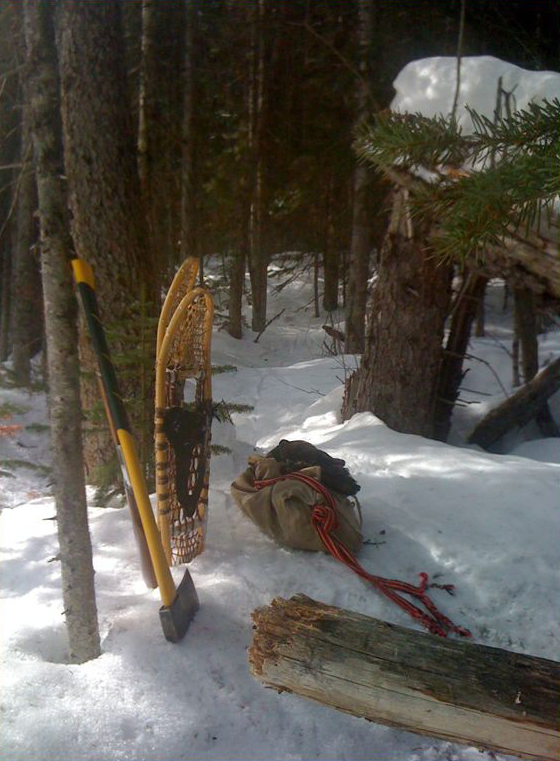
A Tradition of Trapping
Trapping has a long history in rural Canada, and though it is not the thriving industry that it once was, the tradition is carried on by some hardy and passionate individuals. Herb Greene and Frank Alec are two trappers who keep this tradition alive. From November to February they can be found out on the land setting traps, clearing brush, and pushing through the trails on their snowshoes.
“Holding a trapline is a tradition, a way of life, and there’s a whole set of knowledge that goes with it,” says Greene, a long-time woodsman and trapper living in Smithers. “You have to go through training, you have to know how to use the equipment, follow regulations, understand the life cycle and habitat, and how to process the furs so you can get the best price.”
The Trappers Education Course is the first hurdle a person must pass before becoming a trapper. The next step is getting permission to trap on the land. This can be done by acquiring a trapline through the Registered Trapline System, or becoming registered as a trapper for someone else. BC’s registered trapline system came into effect in 1926 and was introduced to decrease conflict among trappers and to create an incentive for a conservation ethic. If trappers over-trap on their traplines, they directly impact their ability to make a living the next season. “Taking care of your trapline is a big part of it,” says Greene.
Real dollars
“Back in the early days, trapping was a way for people on subsistence lifestyles to make something that they could sell for real dollars. The values in the ’30s were substantially higher than what they are now,” Greene says. “As far as the money is concerned, you never know what you’re going to get.” Fur prices vary from year to year, but there is no way to predict what they’ll be. A number of years ago a person could get $1,522 for one lynx; the next year a fur of the same grade was worth just $88. Greene may not look like a man concerned about the latest trends in high fashion, but these trends have a direct impact on the value of his furs.
Before the fur is sold it must be properly prepared. Greene explains the basics and demonstrates the use of some of the equipment. “Here’s a martin killed with a Conibear trap,” he says as he holds up the animal. The Conibear was invented in 1957 by Canadian trapper and blacksmith Frank Conibear. It was designed in response to a call from animal-rights groups for a more humane trap than the leg-hold trap that was currently in use. “Norma Webster, a lady concerned about the cruelty of the old traps, funded Conibear to develop the new trap.” he explains. These are full-body traps that are lethal to the animals and potentially dangerous to the person who is setting it. “You have to be very careful not to get caught in your own trap,” remarks Greene.
He moves on to the boards that are used to scrape and stretch the furs. Manufactured in different sizes, they are of the same design as those hand-made by trappers back in the days of the fur trade. Once the animal is skinned, it is stretched on the board skin-side-out to clean off the fat, and trim and sew any damaged areas.
Connection to the land
Trapping goes beyond the technical details of setting traps and cleaning furs. The connection to the land is integral to how Herb Greene and Frank Alec operate.
Frank Alec grew up trapping in the Burns Lake area. He learned how to trap from his dad when he was 15, and he’s been going back to the bush ever since. The trapline he works belongs in the Frog Clan, which was his Grandpa’s clan. Alec recounts how his grandfather used to sell his furs to the white fur traders, and remarks that the traps he uses today are in the exact same locations as the traps that his grandfather used to use.
On a typical trapping day he leaves town by 5:30 a.m. and drives an hour-and-a-half to the trailhead. He organizes his equipment and is on the trail by 7:30, walking on snowshoes. He checks 71 traps in a day. “It’s especially a long day when there’s a catch. Getting home at 11:30pm, the work begins—preparing the furs must be done right away. If there’s a big animal or six or seven martens, it can be 4:30 in the morning before you are done. It’s a long day.”
Alec recalls what it was like trapping with his father when he was young. “From when I was 15 to about 27, we stayed at the cabin. We’d leave in mid-October and not come home until mid-March. When I was about 19 or 20 we ran out of food out there. My brother used to drop us off at the trail in his Gran Torino. By the time he came back we were living on rice and a few trout. It was very scarce that year. I can’t forget that trip.”
“We’d go every year in mid-March to our buyer, ‘Blackie’ in Prince George. We’d save all our furs and go down into his basement and lay them all out on the floor. Dad and Blackie would negotiate. Dad would nod if the price was good, but he wouldn’t say anything if he thought it was too low. Blackie would mutter and write down a new price. If it wasn’t good my dad would just look away.”
Alec no longer sells his furs. Instead, he gives them away at feasts and potlatches. “I always mention where it came from. This signifies that that land is still alive. It is very important for people in the community, and the elders.” He describes how furs used to be used: “The person that received the fur at the potlatch would give it to someone in their clan to process and make into a cap or gloves, or a coat. Or, they would trade it with someone else for something that they needed. It was the basis for trade and barter; it was an economy on its own.”
Passing it on
Alec is very passionate about passing the knowledge on. “Being out on the land is a way to teach respect for the land, share the stories, and a way to be in touch with the old ways,” he says. “There are many stories and legends out there too, that I needed to know. My stepmom told me a lot of those stories. The stories are about the land, life, and how to behave or solve your problems. I also have all the stories that my father told me, and I am telling them to my sons now. It’s a good feeling, like I’m leaving something behind. It must have been the way my father felt.” In addition to teaching his sons, he also works with other young people on land-based education; teaching them skills that can be applied to surviving in the bush, as well as skills for making good decisions and building leadership.
Greene also spends time teaching children about fur-bearing animals, and the environment they live in. He has visited many elementary school classrooms and enjoys answering the kids’ questions.
Both Alec and Greene plan on trapping for as long as they can, and passing on what they know to the next generation. “It’s a complete cycle,” Alec says.



